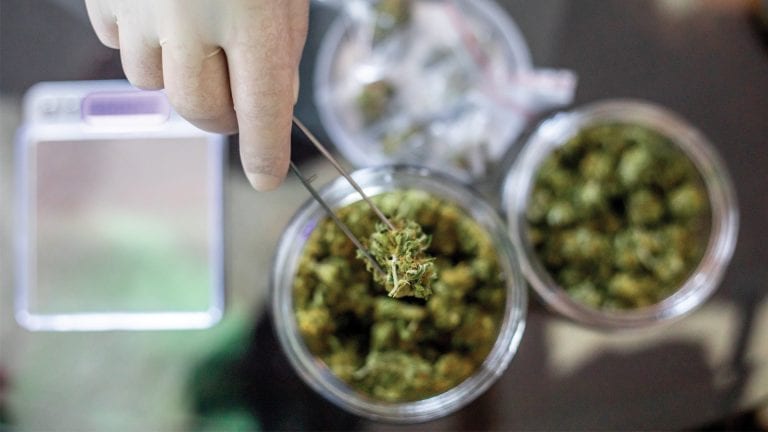Now Is the Time to Bet on Pot Stocks

Pot stocks were hammered in 2019. Nearly every company lost at least 50% of its value. Cannabis demand, on the other hand, continues to climb. This disconnect provides patient investors a clear path to profit.
As with any early-stage market, investors scrambled at the chance to inject pent-up capital into cannabis companies. In 2018, many pot stocks rose by more than 1,000%. By 2019, the hype bubble had popped, sending short-term investors to the sidelines.
Pot stocks were overvalued in 2018, but there’s an argument that the pendulum has swung too far the other way. It doesn’t take a mathematician to realize that many cannabis producers are trading at bargain valuations.
You’ll need to keep a long-term outlook, but now looks like the time to buy beaten-down pot stocks.
Understand what’s happening
Fortune magazine recently ran a story headlined: “Why investors suddenly turned on pot stocks.” The findings were clear.
“Supply and demand issues have wreaked havoc on that Holy Grail of pleasing Wall Street—earnings estimates,” the article claimed. “Despite the roll-out of legal marijuana in Canada, many companies struggled to gauge demand and product mix amid a lackluster number of retail stores in Canada, resulting in an oversupply of product for some. And in the U.S., where cannabis is still federally illegal, the regulatory climate and a vaping crisis last summer only exacerbated cash problems.”
Most analysts expect cannabis to be federally legalized in the U.S. by the end of the decade, while the vaping health crisis was a temporary headwind. Those two issues don’t present permanent challenges. There is one long-term hurdle that the story correctly identifies: oversupply.
Early last year, before the cannabis bear market picked up steam, I published a post titled: The #1 Cannabis Risk That No One Is Talking About.
“At the end of the day, cannabis companies are simply growing crops. The planting and harvesting cycle isn’t too different from corn, tomatoes, or soybean,” I wrote. “Today, it’s not very profitable to grow staples like tomatoes, beans, rice, or cabbage. In another decade, there’s a chance that growing cannabis isn’t wildly profitable either. That reality could crush nearly every cannabis stock. Commoditization could be a lot closer than you think,” I concluded.
By the summer, Tilray revealed that its pricing had fallen off a cliff. Other producers soon followed. And thus the industry-wide downturn began.
A limited-time opportunity
The long-term commodity risk is finally being appreciated by the market. Once high-flying stocks like Green Organic Dutchman Holdings Ltd now have to prove that ramping up pot production can actually result in real profits.
Green Organic was once a billion-dollar company. Today it’s worth just $150 million. Until it can prove that commoditization won’t kill its business, expect the stock to remain in the penalty box.
There are some stocks, however, that trade at depressed multiples but have reasonable plans to overcome long-term commoditization. Hexo Corp is a perfect example.
Hexo’s strategy involves partnering with existing brands like Molson Coors Beverage Co to launch products that consumers already trust. Coca-Cola Co can sell you five cents worth of commodities for a dollar. Hexo is betting it can do the same thing with branded pot.
Many pot stocks have gotten cheap for a reason. Others have been brought down by the industry-wide collapse. It can pay to “buy when there’s blood in the streets,” but just be sure that the stocks you own have strategic partners that can help them brand and differentiate their products.
420 Intel is Your Source for Marijuana News
420 Intel Canada is your leading news source for the Canadian cannabis industry. Get the latest updates on Canadian cannabis stocks and developments on how Canada continues to be a major player in the worldwide recreational and medical cannabis industry.
420 Intel Canada is the Canadian Industry news outlet that will keep you updated on how these Canadian developments in recreational and medical marijuana will impact the country and the world. Our commitment is to bring you the most important cannabis news stories from across Canada every day of the week.
Marijuana industry news is a constant endeavor with new developments each day. For marijuana news across the True North, 420 Intel Canada promises to bring you quality, Canadian, cannabis industry news.
You can get 420 Intel news delivered directly to your inbox by signing up for our daily marijuana news, ensuring you’re always kept up to date on the ever-changing cannabis industry. To stay even better informed about marijuana legalization news follow us on Twitter, Facebook and LinkedIn.




